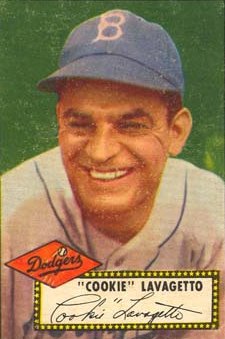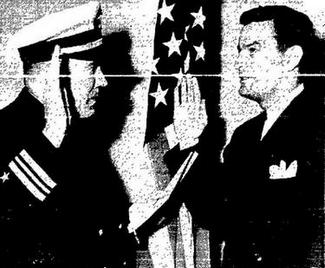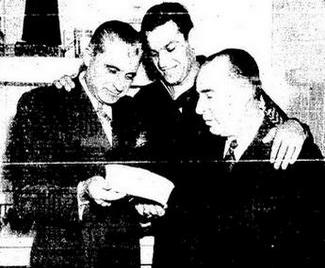

|
|
Cookie Lavagetto
Date and Place of Birth: December 1, 1912 Oakland, California
Died: August 10, 1990 Orinda, California
Baseball
Experience:
Major League
Position: Infield
Rank: Chief Aviation Machinist Mate
Military Unit: US Navy
Area Served: Pacific Theater of Operation
Cookie didn't join up to wear a fancy uniform. He enlisted as a plain gob and requested only one favor. He asked for active duty.
Art Cohn, sports editor Oakland Tribune March 19, 1942
In
late January 1942, Lavagetto filed his application for enlistment
with the Navy. On February 17, he was sworn in as an aviation
machinist mate first class by Lieutenant Commander A R Mack, in
charge of recruiting for the 12th Naval District at San
Francisco. Shortly afterwards, he reported for duty at
Naval Air Station Alameda. “We don’t think enough credit has been given to
Cookie Lavagetto for his enlistment in naval aviation,” wrote Bob
Considine on February 3, 1942, in his weekly column On The Line.
“After all, most of the athletes who have gotten wild applause of
late for their patriotism, were drafted into the services.
Lavagetto, several times chosen as the best third baseman in the
National League, and with five or six prosperous years of baseball
before him, was in Class 3-A and might have remained there even if
we were invaded as deep as Akron. “He enlisted the moment his brother, whom he had
been supporting (along with a number of others) got a defense job.
He felt morally called upon to give to the government his ability to
fly a plane. Anyway, my lid’s off to a good, game guy who, with a
minimum of fanfare and under no compulsion, is doing his bit.” Lavagetto found time to play baseball while with
the Navy in California. On June 22, 1942, he captained the Navy
All-Stars that beat the Oakland Oaks, 5-4. The eleven-inning clash
raised $7500 for the Navy Relief fund. In August 1942, Lavagetto moved to the Naval
Auxiliary Air Station Oakland and was soon an integral part of their
baseball activities. On June 5, 1943, he played in an Army-Navy
all-star game at Seal Stadium in San Francisco. With a line-up
included that featured Charlie Gehringer, Bill Wight, Ray Lamanno,
Joe Hatten and Dario Lodigiani, the Navy won 7-6. By September 1943
Lavagetto was playing ball at Naval Air Station Livermore in
California. The NAS Livermore Fliers clinched the local Army-Navy
league title, winning 60 of 70 games. On April 10, 1945, Lavagetto married Mary Poggi
in Oakland, California. The following month he was shipped to Hawaii
where he managed a Ship Repair Unit ball team – one of the players
under his guidance in Hawaii was a young Stan Musial. Lavagetto was back with the Dodgers in 1946. He
had missed four major league seasons and was now 33 years old, but
the Dodgers held on to him because teams were allowed to keep three
extra GI veterans. In spring training, he injured his arm and had an
operation to remove a bone chip. He played 88 games and batted just
.236. But Lavagetto still had his finest moment ahead of him with a
ninth-inning double that spoiled a no-hitter for Yankees’ pitcher
Bill Bevens in the 1947 World Series. That post season competition,
however, was to mark Lavagetto’s final appearance as a major league
player. Lavagetto returned to the Oakland Oaks - first
professional team he played for – and remained with the from 1948 to
1950. He was a coach with the Brooklyn Dodgers from 1951 to 1954,
the Oaks in 1954 and the Senators in 1955. Lavagetto got his first
managing job with the Senators in 1957 and remained there when the
franchise moved to Minnesota in 1961. He returned to coaching with
the New York Mets in 1962 and 1963, then coached his hometown Giants
from 1964 to 1967. Harry Lavagetto passed away at his home in
Orinda, California on August 10, 1990. He was 77 years old. Created February 27, 2007. Updated April 13,
2007.
Copyright © 2007 Gary Bedingfield (Baseball
in Wartime). All Rights Reserved. 
Lavagetto (right) sworn in by Lt Cmdr A R Mack on
February 17, 1942.
Manuel
Duarte and Vic Dovincenzi, owners of the Oakland Oaks,
study Lavagetto's Navy headwear in June 1942.

